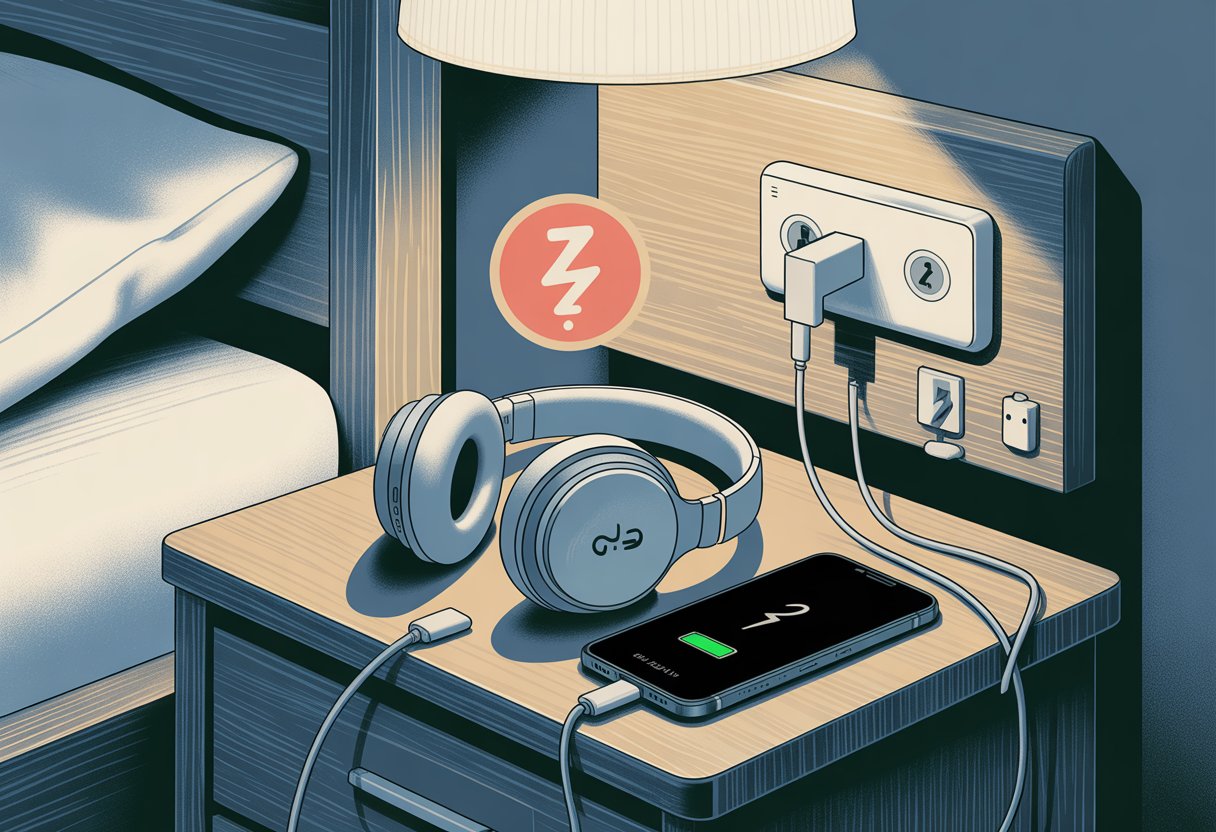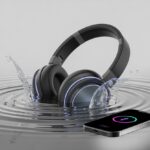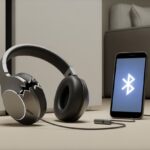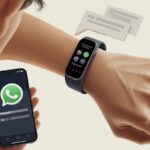We’ve all done it—plugged in our Bluetooth headphones before bed, hoping for a fully charged playlist in the morning. But then, after a whole night of charging, we wake up to silence or a flashing red light that makes us question everything.
Usually, Bluetooth headphones don’t work after charging overnight because the battery, charging cable, or charge port has damage or a bad connection. So, a full night on the charger doesn’t always mean “fully charged” in real life.

Let’s be real—sometimes our headphones act up just because they can. Maybe they’re stuck in “deep sleep” from over-discharge, or the battery is just too old. Some headphones even have safety features that stop them from working while plugged in. (If you wanted to jam while charging, sorry.)
If we’re lucky, the fix is easy—maybe the port’s just dirty or the wire’s loose.
Nobody wants to start their day with a troubleshooting session. Let’s figure out why our Bluetooth headphones are suddenly silent, and see if we can bring our music back to life.
Understanding Bluetooth Headphones Charging
Honestly, plugging in headphones and waking up to a dead set feels a bit like missing your alarm on Monday. The way we charge our headphones overnight really can make or break the whole experience.
Common Charging Methods
Most of us use USB Type-C cables these days, but some headphones still stick with micro USB out of stubbornness. We can plug them into a USB AC adapter, a wall outlet, a computer, a regular USB port, or even a USB hub if we’re feeling risky.
Headphones usually have a charging indicator light. Red or orange means they’re still charging. Green or off? They’re done. Most brands take about 1 to 3 hours to charge, but we often just leave them plugged in overnight so we can sleep while they charge.
Check that cable, though—a loose or broken cable ruins more mornings than we’d like to admit.
What Happens During Overnight Charging
During overnight charging, headphone lithium batteries stop drawing power once full. That’s because built-in cutoff systems prevent overcharging, so we don’t need to worry about frying the battery. Brands like Bose say overnight charging won’t overcharge the battery thanks to smart auto-off features.
Still, if our headphones don’t work the next morning, we might be dealing with a bad connection, a broken charging port, or a battery that’s just given up. Dust or gunk in the charge port can mess things up too.
If the charging indicator doesn’t turn on or stays stuck, it’s probably time to check the cable or try a different USB adapter.
Possible Reasons Your Headphones Aren’t Working After Charging
Plenty can go wrong after leaving Bluetooth headphones plugged in all night. Sometimes it’s the battery, sometimes it’s the charging gear, and sometimes the Bluetooth connection just has a meltdown.
Battery Over-Discharge and Deep Sleep
If the battery drains too far before charging, headphones can enter “deep sleep.” It’s like hibernation, but the headphones ignore us no matter how many buttons we press.
We should connect them to a charger for at least 30 minutes. The charging light might not come on right away, so don’t panic. Maybe take a minute to admire the mess of cables on your desk.
Some models need a longer boost or even a reset—usually by holding down a secret combo of buttons.
Overcharging and Its Effects
Leaving headphones plugged in overnight can sometimes cause overcharging, even though most devices have safeguards. Nothing’s perfect, right?
Overcharging can make the battery swell, lose capacity, or just shut down out of nowhere when we unplug. If the headset feels warmer than usual or acts dead, overcharging could be the villain.
We should unplug headphones once the indicator shows a full battery. Using a good USB adapter (not that ancient cable from the junk drawer) can help avoid these headaches. For more on charging issues, here’s a charging problems guide.
Faulty Charging Cable or Adapter
The humble charging cable can cause chaos. A bad USB Type-C cable or a weak adapter can turn a perfect overnight charge into a fail. If the headset shows no charging light or never gets to full, blame the cable.
Try a different cable and adapter—preferably one that isn’t fraying. If that solves it, retire the old cable with a little ceremony. For a deeper dive, check out these common charging cable problems.
Make sure the charging port is clean. Dust can make a good cable look bad, like a coffee stain on a new shirt.
Connection and Pairing Glitches
Even if the battery’s fine, Bluetooth can be moody. Sometimes headphones just don’t want to pair after charging all night.
Bluetooth headsets sometimes get stuck remembering too many devices, or their software just glitches. Try resetting the headphones and removing them from your device list before pairing again.
Updating firmware or re-pairing with your main device can help. If nothing works, check the manual or ask for help—maybe before tossing the headset out the window. For connection quirks, Sony offers helpful tips here.
Battery Health and Lifespan Concerns
Let’s be honest, batteries don’t age gracefully. If we leave headphones roasting in the sun or treat them carelessly, their battery performance will drop. It helps to know how lithium batteries work so we can avoid silence when we want tunes.
Lithium-Ion Rechargeable Battery Behavior
Lithium-ion batteries act a bit like us—they want to be treated well. They won’t last forever, and they expect some respect. Overcharging, undercharging, or leaving headphones unused for ages all make the battery lose its charge-holding powers.
Charging overnight isn’t always harmless. Over time, constant charging can damage the battery, even if some headphones have protection circuits. It’s smart to avoid draining to 0%, since lithium batteries hate that. They also don’t like staying at 100% or getting hot, which strains their chemistry.
If charging looks normal but headphones don’t turn on, we may have over-discharged or overcharged the battery. Sometimes batteries just quit after a rough life—here’s a story about damaged lithium-ion cells.
Signs It’s Time to Replace the Battery
Sometimes, the battery just gives up. If headphones shut down fast or the power button does nothing, the battery could be done. Uneven battery drain between earbuds, or dropping from full to empty in minutes, are big warning signs.
If the charging indicator flashes weirdly but headphones won’t start up, the battery is probably dying. Charging for hours with no improvement means it’s time for a replacement. Some brands have issues with severe uneven battery drain as batteries age or after updates.
If the battery’s replaceable, swap it out. If not, it might be time for new headphones. Either way, it’s probably the end of the road for your trusty audio buddy.
Effects of Ambient Temperature and Extreme Environments
Batteries hate temperature swings. Charging or using headphones in freezing or super hot places can ruin them. The best range is 10°C to 30°C (50°F to 86°F). Charging outside that range just shortens battery life.
Leaving headphones in a hot car or on a sunny windowsill will make the batteries wear out faster. Going from cold to hot stresses the battery, just like we hate stepping from AC into a heatwave. Improper charging and temperature abuse make the battery drain even faster.
If our headphones always feel frozen or scorching, the battery’s not happy. Keeping them comfortable helps them last longer—and saves our sanity.
Device Compatibility & Bluetooth Issues
Let’s be real—most of us have faced the mystery of Bluetooth headphones going silent after a night on the charger. Sometimes it’s just two devices that don’t want to get along, or maybe it’s a classic failed pairing.
Bluetooth Device Compatibility
Not every Bluetooth device is a team player. New headphones might use Bluetooth 5.2, while our old phone is stuck on 4.0. If versions don’t match, we’ll get connection trouble, dropped music, or no sound at all.
Some phones and computers just refuse to connect, sometimes because of software limits or old drivers. We should check both manuals to see if they’re compatible. If not, updating firmware on our devices or headphones can sometimes get things working.
Here’s a quick table of common compatibility headaches:
| Problem | Possible Cause |
|---|---|
| Won’t connect | Incompatible versions |
| Only one earbud works | Device not supported |
| Audio keeps dropping | Outdated drivers |
Troubleshooting Bluetooth Pairing Failures
Alright, let’s play detective for a minute. First thing I always do? Turn everything off and on again—headphones, earbuds, phones, tablets, whatever’s in the mix.
It sounds basic, but honestly, it solves more problems than I’d care to admit.
Still stuck? I usually check whether my devices actually show up in each other’s Bluetooth lists. If they don’t, the pairing probably failed, so I remove the headset from the list and try pairing again.
Low battery can sneak up on us too, even if we just charged overnight. Some headphones get weird if the battery isn’t holding power well, so if I suspect that, I’ll try a different charger or cable. More on that in this Quora thread about headsets needing charge to work.
Other Bluetooth gadgets nearby can interfere and mess up the connection. I try to make sure nothing else is trying to connect at the same time.
If nothing works, I’ll check for updates or poke around for a reset button—sometimes tech just needs a little attitude adjustment.
Environmental Factors That Affect Charging
Let’s be real: our headphones go through a lot. But they can’t handle everything the world throws at them.
Sunlight, water, dirt, and electrical mishaps can all mess with charging.
Impact of Direct Sunlight, Moisture, and Dust
Leaving headphones baking on a windowsill? Not a good idea. Batteries hate heat, and high temps can damage the battery’s cells and make charging less effective.
If your headphones feel hot enough to fry an egg, that’s a red flag.
Moisture is another sneaky problem. Rain, sweat, or just humidity can get into the charging port.
When water and electronics mix, charging stops—no matter how much you wiggle the cord.
Dust and dirt love to hide in every tiny crack. Grime on the charging contacts blocks electricity and leaves headphones powerless.
A quick wipe with a dry cloth can really help.
Here’s a quick checklist:
- Keep out of direct sunlight
- Avoid moisture and humidity
- Wipe charging contacts clean of dust
Electrical Shock and Safety Considerations
Nobody likes getting zapped. Electrical shock doesn’t just sting—it can fry the inside of your headphones.
Using cheap or mismatched chargers can send the wrong current and ruin the battery or electronics in a flash.
Plugging into sketchy power strips or outlets? That’s risky for both the headphones and for us.
Power surges or shorts might kill the charging circuit for good. I’d stick with the cable and adapter that came with the headphones, or at least a reputable replacement.
So yeah, if we want to avoid fried headphones, let’s keep chargers clean, dry, and far away from danger zones (especially the bathtub).
When to Seek Help or Replacement
Sometimes, after charging our Bluetooth headphones all night, they just won’t wake up and join the party.
If you’ve tried every trick—new cables, careful resets, even a little begging—it might be time to consider other options.
Warranty and Service Options
Nobody really wants to call customer service, but don’t toss those headphones just yet.
It’s worth checking if they’re still under warranty. Most brands give at least a year of coverage.
If you’ve got a valid warranty, reach out for a free repair or, if you’re lucky, a replacement.
Keep your receipt and the original packaging, just in case. The brand’s website usually has info about submitting a claim.
Some brands offer live chat or quick mail-in repair services.
If you’re out of warranty, service centers might repair them for a fee. For pricey headphones, a repair might be worth it.
But if the bill’s almost the same as a new set, maybe it’s time for a shopping trip. For common models, Reddit has tips about where to get help or what others have experienced.
When to Shop for New Headphones
If we’ve already sent our headphones to “tech support heaven” or the repair bill makes us consider a second mortgage, it’s probably time to shop for a new pair.
Older headphones often develop battery or wiring problems that just aren’t worth fixing. I mean, have you seen these tricky charging issues? Yikes.
When you’re picking out replacements, look for better battery life, newer Bluetooth versions, or maybe noise cancellation if that’s your thing.
A comparison chart can help, but honestly, sometimes I just ask the most enthusiastic store employee for their take. They usually have opinions—sometimes too many, but still.
And hey, buying new headphones means we finally get to enjoy “pairing mode” without that sinking feeling it’ll just break again. The thrill of unboxing something shiny almost makes up for the heartbreak of our last pair. Almost.
- How to connect Bluetooth headphones to a Chromebook Without Summoning Tech Support - December 15, 2025
- Best Fitness Trackers for EMS Workers: Because Your Heart Rate Isn’t the Only Thing Racing - December 15, 2025
- Why do my Bluetooth headphones not skip tracks? Tech tantrums and other musical mysteries - December 14, 2025






